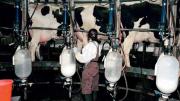The milk we drink today may not be nature’s perfect food,” says Ganmaa Davaasambuu, a Mongolian physician who is a fellow this year at the Radcliffe Institute for Advanced Study. Even as the scientific community has become interested in the effects of the bioactive substances found in pesticides, says Ganmaa, not much attention has been paid to the naturally occurring estrogens found in food, which are both far more abundant and more biologically available than environmental estrogens. In fact, she is concerned that the high levels of hormones found in commercially produced milk may be harmful to human health. Estrogens and other growth factors have been implicated in the development of hormone-dependent cancers: those affecting the prostate, testes, ovaries, breasts, and uterus.
Skeptics note that humans have been drinking milk without apparent harm for millennia, she says. But modern milk is different. Her concern stems not from the use of bovine growth hormone (she excluded BGH-fed cows from her studies), but from the fact that milk-producing cows in commercial dairies, through use of artificial insemination and high-quality winter feed, are kept pregnant and lactating 300 days a year. “Cows are like humans,” she explains. “When they get pregnant, the estrogen levels in their blood, milk, and urine increase. [Tests of pregnant humans detect similar increases.] This made me wonder—since the cows are pregnant all the time, the hormone levels in their milk should be really high.”
While earning her doctorate in environmental health in Japan, Ganmaa began investigating the prevalence and effects of these naturally occurring hormones. In her native Mongolia, traditional patterns of milking—the same as those used in Westernized countries until the 1920s—are still followed: pasture-fed cows are milked only through the first three months of a new pregnancy. Their raw milk had only one-tenth the progesterone that she and her colleagues found in commercially produced milk in Japan.
 |
Mongolian physician Ganmaa Davaasambuu has linked increased tumor formation and growth in laboratory animals with chemically induced cancer to high levels of hormones in commercial milk. Seasonal milking practices among Mongolian nomads ensure that cows produce milk only during the first three months of a new pregnancy, when hormone levels are low. Because modern dairies, on the other hand, milk cows well into their next pregnancy, commercial milk often contains much higher levels of biologically active hormones. |
In a 2002 study of cancer and diet in 42 countries, Ganmaa and colleagues found that countries with the highest consumption of dairy products suffered the highest rates of prostatic and testicular cancer. (A similar study Ganmaa did in 2005 showed much the same results for breast, ovarian, and uterine cancers.) In 2003, the group focused on the relationship between rising rates of these cancers and increased dairy consumption in Japan. Prior to World War II, the Japanese consumed very little milk, and rates of these cancers were low. But in the 1950s, a school-lunch program that included milk was instituted nationwide. Since that time, the intake of milk has increased twentyfold, and the incidence of prostate cancer has increased twenty-five-fold.
Still, such epidemiological evidence is circumstantial. But in a 2004 study that used rats in which mammary cancer had been induced, she and her colleagues found that rats fed low-fat milk (1 percent) were more likely to develop tumors, and in greater numbers and of larger size, than rats fed water or artificial milk. In a 2006 study, also in rats, she proved that the hormones in milk are biologically active in animals. Both adult and immature milk-fed rats showed increased uterine weight—the gold standard for measuring the estrogen activity of food and other substances.
During her time at Harvard, which began with a year as a research fellow at the School of Public Health under Stare professor of epidemiology and nutrition Walter Willett, she and her colleagues have conducted two pilot studies. The first compared American milk (whole, whole organic, skim, and “shelf-stable” ultra-high temperature milk) to milk from Mongolia. Levels of hormones and growth factors were low in both American skim milk (hormones are carried in the milk fat) and Mongolian milk. In a subsequent study, Mongolian third-graders were fed U.S. commercial milk for a month. The good news was that a number of the children who had been vitamin D-deficient when the study began saw those deficiencies corrected. “Milk is a complex food that contains many good things, such as vitamin B, vitamin D, and calcium,” Ganmaa notes. But the Mongolian schoolchildren’s growth- hormone levels shot up 40 percent; and the children grew, on average, one centimeter during the month—a statistically significant increase, according to Ganmaa. “But we don’t know if it will be sustained in the long term, whether it will affect their sexual maturation or their age at puberty,” she says. “One month is too short.” She and her Harvard colleagues are now seeking funding for a two-year study.
Based on what she has found so far, Ganmaa believes that cows in late pregnancy should not be milked—or, at least, that such milk should be labeled to indicate that it comes from a pregnant cow. In the meantime, it is reassuring to know that skim milk from the United States has low levels of hormones, just like the traditional stuff from Mongolia.
~Jonathan Shaw
Ganmaa Davaasambuu e-mail address: gdavaasa@hsph.harvard.edu






